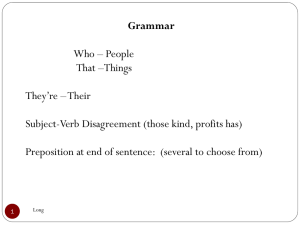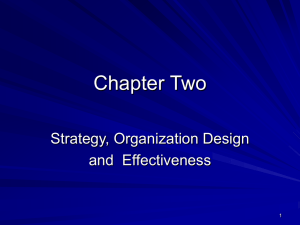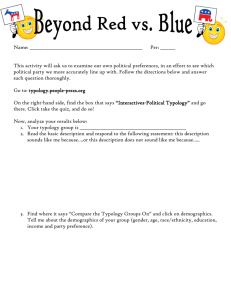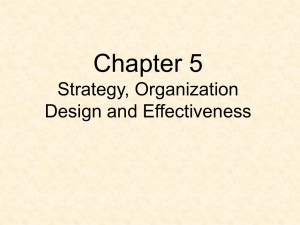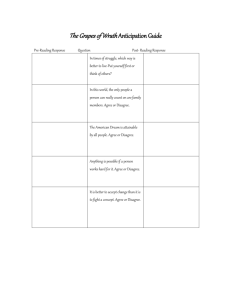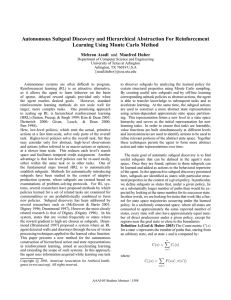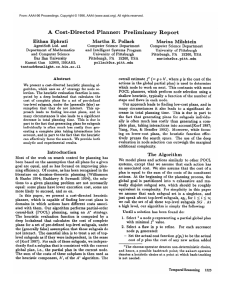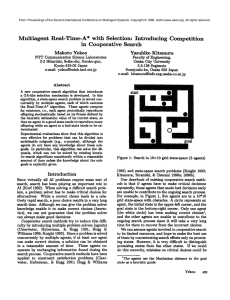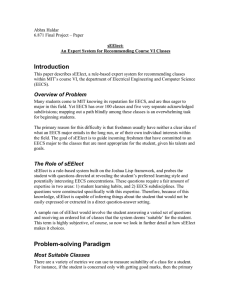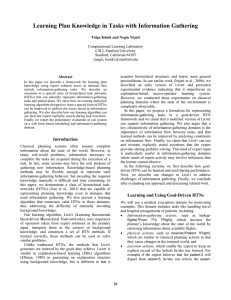MSStrategylt-Chapter2
advertisement
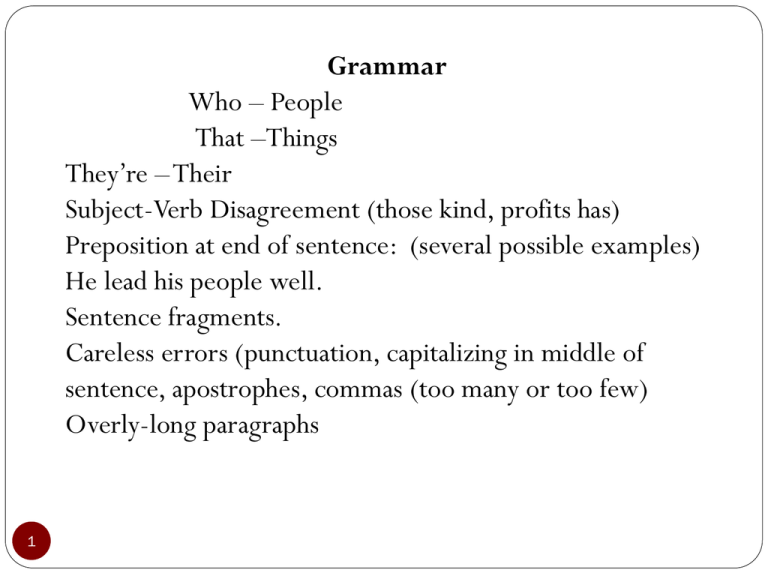
Grammar Who – People That –Things They’re – Their Subject-Verb Disagreement (those kind, profits has) Preposition at end of sentence: (several possible examples) He lead his people well. Sentence fragments. Careless errors (punctuation, capitalizing in middle of sentence, apostrophes, commas (too many or too few) Overly-long paragraphs 1 MGT 4153 Dr. Jimmy Richardson Role in Strategic Direction Organizational goal is a desired state of affairs that the organization attempts to reach. Top executives decide organizational goals. Q1: A company’s strategic intent or direction reflects managers’ systematic analysis of organizational and environmental factors. Agree or Disagree? Organizational design is the administration and execution of the strategic plan. 3 Long Strategic Intent Means that all the organization’s energies and resources are directed toward a focused, unifying and compelling overall goal. Three aspects related to strategic intent are the mission, core competencies and competitive advantage. Mission – reason for existence. Mission statement communicates to current and prospective employees customers, investors, suppliers and competitors what the organization stands for and is trying to achieve. 4 Long "The Coca-Cola Promise: The Coca-Cola Company exists to benefit and refresh everyone it touches. The basic proposition of our business is simple, solid, and timeless. When we bring refreshment, value, joy and fun to our stakeholders, then we successfully nurture and protect our brands, particularly Coca-Cola. That is the key to fulfilling our ultimate obligation to provide consistently attractive returns to the owners of our business." 5 Long Our Mission Statement The mission of Southwest Airlines is dedication to the highest quality of Customer Service delivered with a sense of warmth, friendliness, individual pride, and Company Spirit. 6 Long Question 2: The best business strategy is to make products and services as distinctive as possible to gain an edge in the marketplace. (Agree or Disagree) 7 Long Core Competence or Competencies Something the organization does especially well in comparison to its competitors. (Ex: superior R&D, tech skills, exceptional customer service) 8 Long Competitive Advantage What sets the organization apart from others and provides it with a distinctive edge for meeting customer or client needs in the marketplace. (Walgreens) Operative Goals represent the primary tasks of the organization where official or overall goals describe more of a value system. 9 Long Framework for Selecting Strategy and Design A strategy is a plan for interacting with the competitive environment to achieve organizational goals. Goals are where the organization wants to go and strategies define how it plans to get there. Two models for formulating competitive strategies are the Porter model and Miles and Snow’s strategy typology. 10 Long Porter’s Competitive Strategies (page 60-63) Low-Cost Leadership: Concentrates internally on cost reduction and efficiency Differentiation: Concentrates externally on quality and customer perceptions Focus: Concentrates cost or differentiation by geographic or buyer group 11 Long Miles & Snow’s Strategy Typology Prospector: Innovation, risks, new opportunities, and growth (Nike, Facebook, Google, MySpace) Defender: Risk avoidance, stability/retrenchment, efficiency, and control (Paramount) Analyzer: Core stability, peripheral innovation, diverse approach depending on product (Midway between Prospector and Defender – [Amazon.com]) Reactor: No mission, goals, strategy (No strategy at all!) 12 (Dell) (Porter’s Competitive Strategies & Miles and Snow’s Strategy Typology compared on page 65) Question 3: The best measures of business performance are financial. (Agree or Disagree) 13 Long Contingency Approaches to the Measurement of Organizational Effectiveness External Environment Organization Resource Inputs Resource-based approach 14 (page 76) Internal activities and processes Internal process approach Product and Service Outputs Goal approach Four Models of Effectiveness Values STRUCTURE Flexibility F O C U S Human Relations Emphasis Open Systems Emphasis Primary Goal: human resource development Subgoals: cohesion, morale, training Primary Goal: growth, resource acquisition Subgoals: flexibility, readiness, external evaluation Internal Internal Process Emphasis Rational Goal Emphasis Primary Goal: stability, equilibrium Primary Goal: productivity, efficiency, profit Subgoals: planning, goal setting Subgoals: information management, communication Control 15 Long External
